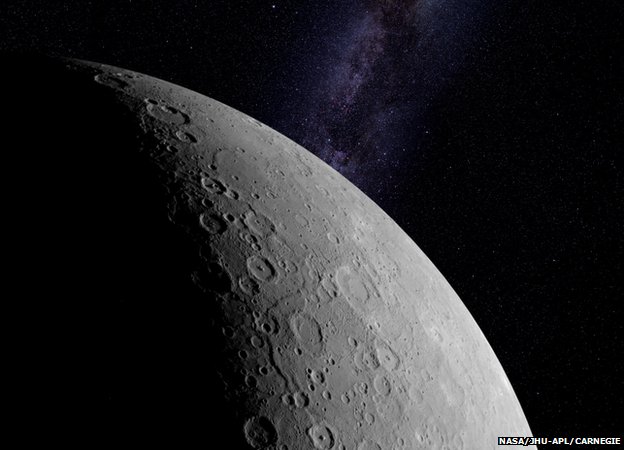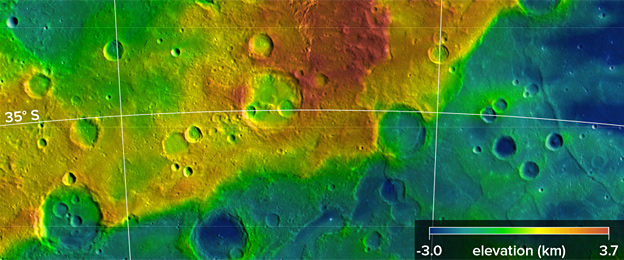.

Mercury is 4,880km wide and is dominated by its giant iron core
.
The planet Mercury is about 7km smaller today than when its crust first solidified over four billion years ago.
The innermost world has shrunk as it has cooled over time, its surface cracking and wrinkling in the process.
Scientists first recognised the phenomenon when the Mariner 10 probe whizzed by the planet in the mid-1970s.
But the latest images from the US space agency's Messenger satellite have enabled researchers to refine their estimate for the amount of contraction.
And, as they report in the journal Nature Geoscience, it is significantly more than previously realised.
Mariner made two passes of Mercury, in 1974 and 1975, photographing about 45% of the planet's surface.
Evident in those pictures were long scars where rock had been thrust upwards as the body shortened.
These lobate scarps, as they are known, typically run for hundreds of kilometres, and separate terrains that can differ in height by thousands of metres.
From the Mariner evidence, researchers calculated Mercury must have decreased its radius by about 1-3km over its history.
But that figure was in conflict with modelling studies that suggested a cooling object like Mercury should have contracted much more in four billion years.
Messenger helps to resolve the inconsistency. Since entering into orbit in 2011, it has photographed 100% of the planet.
This has allowed for a more extensive study of the scarp features and the more subtle wrinkled ridges that also criss-cross its surface.
The new assessment now brings the observed shrinkage - a reduction in radius of 7km - into the realm expected by the models.
Dr Paul Byrne from the Carnegie Institution in Washington DC is the lead author on the Nature Geoscience paper. He marvelled at the surface features on planet.
"Some of these lobate scarps are enormous," he told BBC News.
"There's a structure called Enterprise Rupes in the southern hemisphere that is a single scarp system. It's 1,000km long and in places has 3km of relief. Imagine standing in front of it. It's Mercury's version of a mountain belt.
"It utterly dominates the topography and it is astounding given the diminutive size of Mercury."
The innermost world is a fascinating oddball. Whereas the Earth has an extensive crust and mantle shrouding its metal core, Mercury is very different.
Estimated to be nearly 4,000km in diameter, the planet's metal core is its defining feature. It is covered only by a thin rocky veneer that may be little more than 400km thick.
Although some of the core must still be liquid, part of it will have cooled and solidified, losing volume as a result. This will have scrunched the thin, overlying layer of rock.
Europe and Japan plan to launch a joint mission to Mercury to follow up Messenger's observations
The BepiColombo venture should launch in 2016. One of its principal investigators will be Dr Dave Rothery from the UK's Open University.
"People used to think the Earth was shrinking - which it is a little bit, but we can't see it because of the way tectonic plates are created and destroyed on the Earth," he explained.
"Before we understood plate tectonics, people thought mountain belts on Earth were because the planet was shrinking and forcing stuff upwards, and areas of thick accumulation of sediment were where the crust was being forced down by contraction. We now know that's broadly speaking wrong, but this is the process on Mercury because it's a one plate planet."
This has relevance as scientists try to understand planets beyond our Solar System. Many of these, too, may have just the single plate and exhibit very similar surface-crumpling features to those seen on Mercury.
.

Mountain ranges: Mercury is covered with massive scarps where the surface has shortened
Quelle: BBC
.
Mercury's Contraction Much Greater Than Thought
New global imaging and topographic data from MESSENGER show that the innermost planet has contracted far more than previous estimates. The results are based on a global study of more than 5,900 geological landforms, such as curving cliff-like scarps and wrinkle ridges, that have resulted from the planet's contraction as Mercury cooled. The findings, published online today in Nature Geoscience, are key to understanding the planet's thermal, tectonic, and volcanic history, and the structure of its unusually large metallic core.
Unlike Earth, with its numerous tectonic plates, Mercury has a single rigid, top rocky layer. Prior to the MESSENGER mission only about 45% of Mercury's surface had been imaged by spacecraft. Old estimates, based on this non-global coverage, suggested that the planet had contracted radially by about 1/2 to 2 miles (0.8 to 3 kilometers), substantially less than that indicated by models of the planet's thermal history. Those models predicted a radial contraction of about 3 to 6 miles (5 to 10 kilometers) starting from the late heavy bombardment of the Solar System, which ended about 3.8 billion years ago.
The new results, which are based on the first comprehensive survey of the planet's surface, show that Mercury contracted radially by as much as 4.4 miles (7 kilometers) -- substantially more than the old estimates, but in agreement with the thermal models. Mercury's modern radius is 1,516 miles (2,440 kilometers).
"These new results resolved a decades-old paradox between thermal history models and estimates of Mercury's contraction," remarked Paul Byrne, a planetary geologist and MESSENGER Visiting Investigator at the Carnegie Institution of Washington. "Now the history of heat production and loss and global contraction are consistent. Interestingly, our findings are also reminiscent of now-obsolete models for how large-scale geological deformation occurred on Earth when the scientific community thought that the Earth only had one tectonic plate. Those models were developed to explain mountain building and tectonic activity in the nineteenth century, before plate tectonics theory."
Byrne and his co-authors identified a much greater number and variety of geological structures on the planet than had been recognized in previous research. They identified 5,934 ridges and scarps attributed to global contraction, which ranged from 5 to 560 miles (9 to 900 kilometers) in length.
The researchers used two complementary techniques to estimate the contraction from their global survey of structures. Although the two estimates of radius change differed by 0.6 to 1 mile (1 to 1.6 kilometers), both were substantially greater than old estimates.
"I became interested in the thermal evolution of Mercury's interior when the Mariner 10 spacecraft sent back images of the planet's great scarps in 1974-75, but the thermal history models predicted much more global contraction than the geologists inferred from the scarps then observed, even correcting for the fact that Mariner 10 imaged less than half of Mercury's surface," noted MESSENGER Principal Investigator Sean Solomon, of Columbia University's Lamont-Doherty Earth Observatory. "This discrepancy between theory and observation, a major puzzle for four decades, has finally been resolved. It is wonderfully affirming to see that our theoretical understanding is at last matched by geological evidence."
Quelle: NASA
5282 Views
